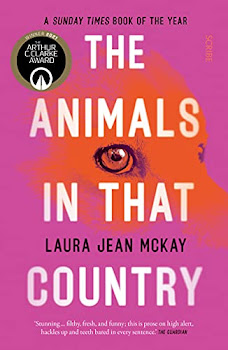The Animals In That Country
The first five pages of The Animals In That Country consist only of quotes singing its praises. They’re packed with words like vibrant and energetic, subversive and wonderful, imaginative and original. For me it’s an exercise in unreadability.
Set in an Australia where the outbreak of a flu variant permits humans to talk to animals, TAITC is narrated by a 60-something (?) woman on the trail of her kidnapped granddaughter, accompanied on her journey by a dingo named Sue. Sue, and all the other animals encountered, speak like this:
No locks for
Mother (the
metal tooth).
Run for tomorrow.
Not only is this hard to understand, it’s also hard to read, because rarely is any of it explained. The reader’s left to puzzle these utterances out, and that slows the book right down. As does the voice of the narrator, a booze-swilling, defiantly free-spirited individual. She speaks in the present tense, in staccato sentences that drop connective words with abandon. Here’s a sample:
Breeze on my skin and wispy hair. The stink of leaves on poo on piss on fur. Something dead. Something lively. The park beautiful this way.
This never stops. It never wavers. The entire book – all 277 pages of it - is written in the same clipped, frantic style - and there’s never a moment of relief. At no point is there any modulation or fluctuation in pace. Reading it is like sticking your finger into an electric light socket and keeping it there. It’s exhausting.
To some, this will be an accurate rendition of the characters’ – human and animal - speech and thought patterns. It's subversive and original. That’s a valid interpretation. To me, it reads like a first draft hammered out at speed, just to get the words down on paper so as to be able to work them up into something halfway readable.
One thing’s for certain though. The next time I spot a book by an unknown author that comes piled with plaudits, I will go out of my way not to buy it.



Comments
Post a Comment